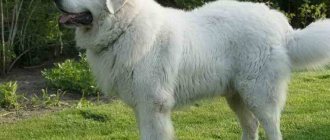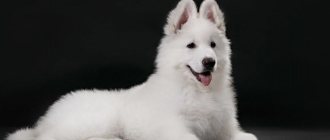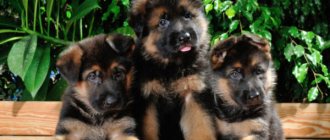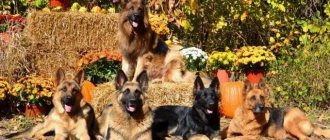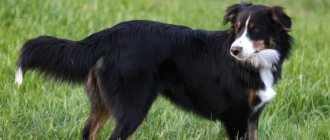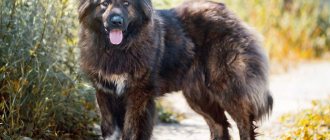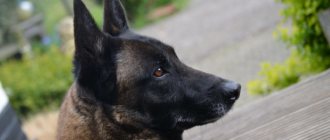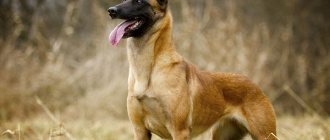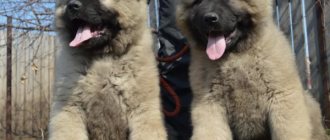Brief historical background
The first written mentions of these shepherd dogs, dating back to the 1st century BC, are found in the works of the ancient Roman writers Varro and Columella, who describe snow-white Italian shepherd dogs guarding flocks of sheep and goats . It is not possible to accurately establish the family tree due to the remoteness of the events, but it is believed that these animals were brought to the European continent by Asian nomadic peoples. Among the ancestors of the Maremma are mastiff dogs, Tibetan wolfhounds and steppe mastiffs. The appearance of the Abruzzese Shepherd Dogs has remained virtually unchanged since then.
Initially, there were two varieties of white shepherd dogs, visually different and living in different regions of Italy (Tuscan Moremma, Lazio and Abruzzo). However, as a result of seasonal distillation of cattle, natural crossing occurred, the breeds mixed, forming one - the Maremma-Abruzzese. Since each of the regions claimed that shepherd dogs first appeared on their territory, and the parties could not reach an agreement, the breed received a double name - as a compromise.
Maremma - a shepherd dog that guards sheep
In 1898, the first individuals of the Maremma-Abruzzese Sheepdog were included in the studbook of the Italian Kennel Club; the first breed standard was developed in 1924 (two types of dogs were considered there). In January 1956, the standard characteristics were finalized, combining both species under the general name Maremmano-Abruzzese Sheepdog. In the same year, the breed was recognized by the world community. In the FCI register it is listed in group 1 - herding and cattle dogs (section 1 - shepherd dogs) under number 201.
The latest valid and current breed standard dates back to September 15, 1992.
History of the origin of the breed
History tells that this breed of dog first appeared on the lands of Italy. They were brought to this region by Aeneas, who fled from Troy. Scientists do not really trust legends, and therefore the official version of the appearance of this dog breed is based on the fact that the ancestors of modern Abruzzese shepherd dogs were ordinary Asian shepherd dogs. It is assumed that they accompanied the Aryan nomads who moved to Europe from the Tibetan mountains.
The mention of reliable written sources in the first places sends humanity back to the first century AD, where they already carried out an important security mission.
The name of the Italian Shepherd is associated with two cities in Italy: Abruzzo and Maremma. Residents of the cities fell in love with the snow-white dogs, and as a result, many disputes arose about what name to give to the faithful protectors. Without reaching a consensus, people found a compromise and called the breed “Maremma-Abruzzese”.
Italy is not the only country that has been conquered by these dogs. After a very short period of time, all of Europe expressed its admiration for the affectionate nature and remarkable appearance of such shepherd dogs.
Despite universal love, the Maremma-Abuzz Shepherd was recognized as a separate dog breed by the International Canine Organization only in 1956.
Description of the Italian Maremma-Abruzzese Shepherd Dog
According to the standard, the Maremma Abruzzese Shepherd Dog is intended to be used as a shepherd for herds of livestock, as well as for guarding property. Recently, these large dogs are increasingly kept as pets and family members.
Breed standard
The Maremma's physique is massive and rough, but at the same time aristocratic and majestic. A large, well-balanced, strongly built body of an elongated format (the length exceeds the height at the withers) with widened withers rising above the straight line of the top, a short, slightly curved, muscular loin, a powerful, well-developed, wide, sloping croup, deep, sloping to the elbows, rounded in the middle part of the sternum and elongated, curved in the form of an arch, tucked up by the abdominal line.
Maremma is a strong and large dog
Breed standard:
- The large, flat head has a conical shape (resembling the head of a polar bear) and is set on an extremely powerful, thick and muscular neck (without dewlap) with a thick collar of elongated hair. The skull is very wide with moderately pronounced brow ridges, a faintly visible intermediate frontal groove and a slightly defined occipital crest. The muzzle is flat, tapering towards the nose. The stop is slightly marked.
- The nose is large, with wide open nostrils, located along the line of the muzzle, does not protrude beyond the front edge of the lips (if viewed in profile), and is pigmented black.
- Well developed, impressive-looking, powerful jaws with strong white teeth in a regular scissor bite. The dental formula is complete. Underdeveloped, thin black lips barely cover the teeth.
- The not too large almond-shaped eyes are set normally (not protruding, but not deep), the eyelids are edged with black. Iris of brownish tones (chestnut-brown or ocher). The look is meaningful, lively and attentive.
- Small (up to 12 cm in length), pointed, drooping and movable triangular ears are located very high. Docking is permissible only in working individuals actually grazing livestock.
- Densely covered with hair (without dewlap), the low-set tail is lowered in a calm state, and when excited or in motion it rises to the line of the back. The tip of the tail is curved.
- Limbs are straight, parallel, well muscled. The paws are round, wide with closed toes, densely covered with short, stiff hair. Nails chestnut or black (preferred).
- Height at withers: females - 60–68 cm;
- males - 65–73 cm.
- females - 30–40 kg;
The Maremma moves with a confident, sweeping step or a wide trot. Constant ambling is unacceptable.
Features of the coat
The coat is straight (a slight wave is allowed), long (up to 8 cm), thick and hard to the touch with a dense, abundant undercoat that appears only in the cold season. There is a large collar on the neck, and small feathering on the hind legs. On the front of the limbs, on the skull, muzzle and ears, the hair is noticeably shorter. The color is exclusively pure white, the standard allows only small areas of light shades of lemon, light reddish or beige (ivory).
Maremma coat color can only be white
Grounds for exclusion and disqualifying characteristics
The reasons for disqualification will be:
- undershot or obvious undershot;
- depigmented nose or eyelids;
- concave or convex muzzle;
- strabismus;
- uneven coloring of the iris;
- curly wool;
- clearly visible spots (black, ivory or “isabella”);
- short tail or lack thereof;
- severe behavioral or physical abnormalities;
- cowardice or aggressiveness.
Description of the breed
Residents of the two Italian regions of Maremma (with access to the sea) and Abruzzo (mountainous region) had long-term disputes regarding the ownership of this breed. It was decided to pacify the emotional squabbles by adopting a double name for the breed - Maremmano-Abruzzese Shepherd Dog. The herds were regularly driven along these places, and the dogs gradually formed under the influence of the climatic and landscape conditions of both territories. In 1958, a complete breed standard was adopted with a thorough description of it.
According to the classification of the Fédération Cynologique Internationale (FCI), the Italian Shepherd (the full name sounds like Maremmano-Abruzzese) belongs to the group “Shepherd and cattle dogs, except Swiss cattle dogs” in the “Shepherd Dogs” section.
The Italian Shepherd Maremma is quite large. Thus, males are larger than females and reach 73 cm in height and 45 kg in weight. Females are shorter - up to 68 cm, and lighter - up to 40 kg. Lightness and height help dogs perform all their intended functions. Life expectancy is about 13 years.
The muzzle should not be long, but rather wide and short, reminiscent of the muzzle of a polar bear. Dark nose, lips and paw pads. The ears are not docked and have a triangular shape with a length of up to 12 cm.
Eyes, ears, claws and paw pads are subject to careful inspection and care. They need to be cleaned and kept in order regularly.
The color of the dogs is white, areas of ivory, light lemon or orange shade are allowed.
The translucent, hard hair on the body and tail reaches a length of 8 cm, and on the head it is short. On the neck the fur grows abundantly, forming a dense collar. This is a kind of barrier against bites in a vulnerable place. For centuries, shepherds have placed spiked collars on maremmas as additional protection.
The coat of white shepherds can be slightly wavy, but in no case curly. This is not a whim or a matter of principle, but a necessity. Thus, airy, highly curly wool will not be able to protect the inner thick (especially in winter) undercoat from getting wet in rain and snow. A chilled dog will be forced to leave the herd and dry off. The same as in the heat - loose fur will allow hot air to pass to the skin and incapacitate the dog. She will have to seek shade to cool down. And in the absence of a maremma “on duty,” irreparable things can happen. What makes this breed so good is that it contains a whole range of amazing, very intelligent natural qualities, bred over thousands of years.
An interesting fact is that dirt does not linger on the snow-white fur of dogs. Once dry, it crumbles on its own, requiring no additional care. This effect is probably achieved due to a thin coating of sebum on the hair. In this case, of course, the owner must comb out the pet’s thick fur at least 1-2 times a month. For show dogs, these procedures are performed more often.
Dogs of this breed shed 1-2 times a year. Before shedding, you can bathe your dog, then the process will go faster. Again, demonstrators bathe more often. It is important to note that the fur of these dogs is practically odorless and hypoallergenic.
Character of the breed
The Maremma-Abruzzese Shepherd Dog has a very complex and unique character, which has been developed over centuries of independent work as a guard and shepherd . A self-sufficient and independent dog does not obey anyone; it accepts only partnerships. She does not recognize unconfirmed power and dominance, guided only by her own instincts. Only an authoritative owner can truly respect.
The entire being of the maremma is imprisoned under the protection of the owner's property and livestock. But it does not guard thoughtlessly; the animal is able to assess the situation itself and make its own decision, without waiting for a command from the owner. Possessing a strong sense of territoriality, the shepherd dog vigilantly controls the boundaries of the area entrusted to it, trying to keep as large an area as possible in its field of vision. The pet does not lose vigilance for a minute, being ready at any moment to overtake and repel the enemy.
Maremma always watches everything vigilantly
These snow-white shepherds are affectionate and gentle with members of their family; they are not only magnificent protectors, but also the most devoted, reliable friends. They are extremely wary of strangers, constantly monitoring their actions and movements. But they never show open aggression without a compelling reason. A smart dog is able to correctly assess the current situation and adhere to a certain line of behavior.
At night, Abruzzese Shepherds are especially vigilant. If during the day guests are allowed to move freely around the host’s property, then at night it is better to refrain from walking in the moonlight, because it is completely unsafe.
Maremma is infinitely patient and kind with her master's children, allowing her to do almost anything with her. A calm and balanced dog cannot be disturbed from its state of balance. However, such tolerance does not extend to the neighbor's brats, who extremely irritate the sensitive animal with noise and stupid running around. The dog gets along well with other pets and does not even conflict with cats. But on the street, large males can fight in the fight for a female.
Maremma is very loyal to children
There have been many cases of causeless aggression on the part of representatives of this breed towards people. In most cases, this manifests itself in an attack on their food, which the Maremma treats with extreme reverence.
Character and intelligence
The character of the four-legged friend is very difficult. There is one quality of her character that confirms her title as a hunter. The shepherd is capable of attacking the enemy very quickly. When the shepherds took the flock out to the meadow, the dog got lost among them and calmly waited for the end of the day.
If any predator came close to the herd, the shepherd quickly jumped out of the thick of the white sheep and, growling, pounced on the offender. Once a case was recorded when a dog drove a bear away from the herd for 3 hours. The Maremma-Abuzz Shepherd perfectly controls the perimeter of the territory; no one can hide from its gaze. In the vicinity of a person, the dog is unpretentious and easily agrees to a leash.
How to choose a puppy
You should purchase a Maremma baby only in specialized nurseries or from certified breeders, because all matings are carried out with the permission of official clubs and are recorded in the stud books. It is advisable to first assess the living conditions of the dogs and look at the parent couple. A conscientious breeder will not only provide the necessary set of documents (puppy card, parents’ pedigrees, veterinary book with notes on vaccinations, etc.), but will also provide practical recommendations on feeding and maintenance.
It is extremely difficult for a layman to distinguish an Italian Shepherd puppy from other visually similar breeds and various crossbreeds. Some guidance can be the characteristic shape of the head, very reminiscent of the head of a polar bear.
Average cost of a puppy of this breed
The price of Maremma-Abruzzese Shepherd puppies varies from 30 to 80 thousand rubles, it depends on the title of the parents and the prospects of the baby.
A pet without documents, purchased through an advertisement, will cost much less (15–25 thousand), but in this case there is an extremely high risk of purchasing an outbred animal that does not have any breed characteristics or is burdened with a whole bunch of hereditary pathologies.
Italian Shepherd puppies are easy to find
Advantages and disadvantages
Like any breed, the Maremma-Abruzzese Shepherd has both advantages and disadvantages. Its positive features include:
- devotion to the owner;
- security qualities;
- fairly easy care;
- high intelligence;
- ability to learn;
- good attitude towards children;
- good health.
Expert opinion
Anna Abramenko
An avid dog lover. Experience in veterinary medicine since 2009.
Ask a Question
Adult individuals no longer need activity as urgently.
Cons of a dog:
- wariness of strangers;
- rancor;
- tendency to unmotivated aggression;
- touchiness;
- frequent barking due to increased noise, perceived by the maremma as a source of danger.
The shepherd has more advantages than disadvantages. Both of them must be taken into account by every person who wants to have one as a pet.
Keeping the Maremma-Abruzzese Shepherd Dog
Large and active Abruzzese Shepherd Dogs feel best free-range in a private or country house (in a large enclosure or courtyard) . The dog can live outdoors all year round; you just need to equip it with an insulated kennel. Although she will sleep completely peacefully, curled up right in the snow (the fur allows it). This breed vitally needs freedom and independence; its representatives cannot be kept on chains, otherwise outbursts of aggression and unmotivated anger are guaranteed.
Keeping a maremma in a city apartment is undesirable for the owners themselves rather than for the animal. The dog is able to adapt to a cramped apartment space, but will sweep away everything in its path, and also leave tufts of white fur everywhere during active molting.
Features of training a maremma
Despite everything that was said above about the stubborn nature of the Maremma, it lends itself well to education and training. Such dogs train well, grasping information and quickly assimilating - the main thing is to start their socialization early so as not to waste time. It involves walking with your dog in crowded places on a leash - you can ride in a car, go on public transport, go to parks and unfamiliar places.
Experienced dog handlers recommend starting training a dog of this breed as early as possible in order to completely get rid of the factors that provoke aggression. The most dangerous period for the Maremma, from six months to two years of age, will pass more gently if by this time the dog has already accepted the dominant position of the owner and obeys him.
From a young age, a dog of this breed must clearly understand that the owner is the most important and the strongest, and the members of his family are under his protection. Therefore, any manifestation of dissatisfaction, baring of teeth and growling must be immediately suppressed. To do this, just take it by the skin and lift it slightly, then press it to the floor and hold it until it starts to break out. All these manipulations are much more convenient to perform with a small puppy than with a maturing dog.
Features of caring for the Italian Maremma Cattle Dog
Caring for an Italian Shepherd is not particularly difficult.
Hygiene
Hygiene procedures:
- comb at least 2-3 times a week using a strong metal brush and slicker brush, daily during the period of active molting (spring, autumn);
- water treatments as needed, but not more than 1-2 times a year, using special shampoos for long-haired animals;
- weekly examine your ears and eyes, wipe them with zoo lotion, herbal decoction or simply boiled water;
- Once every 10–15 days, brush your teeth with a brush and specialized toothpaste for animals;
- shorten the claws once every 3-4 weeks if they do not grind down on their own.
Walk
Agile and active Italian Cattle Dogs need serious physical exercise, especially for puppies. You will need to walk your pet twice a day for 1.5–2 hours; you can safely take it with you in the morning for a run in the park, on a bike ride or on a hike.
When walking, the Maremma must run freely without a leash.
The Maremma breed is not recommended for inactive people and couch potatoes.
Nutrition
Most often, large working dogs are kept on a natural diet, which consists of:
- lean meat (horse meat, beef, rabbit, etc.);
- offal (kidneys, heart, lungs, etc.);
- scar, cartilage, veins, etc.;
- sea fish;
- unrefined vegetable oil (olive, sunflower);
- cereals (buckwheat, egg, rice, etc.);
- eggs (chicken and quail);
- low-fat and unsweetened sour milk (kefir, cottage cheese, etc.);
- seasonal vegetables (carrots, zucchini, cabbage, etc.) and herbs;
- fruits (pears, apples), berries;
- bran;
- vitamin and mineral supplements.
It is forbidden to give shepherd dogs sweet, fatty, highly salty, peppery, hot and smoked foods, as well as baked goods and pasta.
It is permissible to feed the Maremma with dry store-bought food, selecting formulations of at least a premium class, designed for large breeds (Bosch, Akana, Hills, etc.). Adults are given food twice a day, puppies are fed more often (3-6 times) depending on their age.
When a maremma is eating, it is better not to get close to it
Maintenance and care
Feeding
Maremmas eat simple food intended for large working dogs, be it natural or dry food. You can study the instructions for feeding a German Shepherd; these breeds have similar needs.
Large size with proportional addition during the growth period does not require high calorie food, as when growing Molossers. Chondoprotectors for the proper formation of joints and ligaments are necessary only during the period of active growth of the puppy.
Keeping a dog in an apartment
There is an opinion that the Maremma will suffer if kept in an apartment. This is not entirely true, because apartment maintenance poses difficulties primarily for the owners . This also applies to the dog’s profuse shedding twice a year, when the apartment is strewn with “poplar fluff,” and the peculiar aroma of dead meat in which these dogs love to roll. And the need for daily long walks, which the pet urgently needs.
Keeping it in the yard is ideal for maremma, which is not afraid of frost or hot weather. Thick coat and dense soft undercoat protect the dog from rain, cold and wind, and in summer they prefer to rest in the shade of trees.
Wool can clean itself, since the guard hairs have a smooth surface, and dirt quickly rolls off from them, only after drying slightly. You will have to brush your dog daily to prevent the thick, soft undercoat from becoming tangled. You can wash it rarely, before exhibitions or after heavy soiling.
Training and education of the Maremma-Abruzzese Shepherd Dog
It is necessary to socialize and train an Italian Cattle Dog puppy from a very early age, since even babies are willful and independent . These shepherd dogs can be trained quite well, but when working with them, the owner needs to be firm and persistent, and sometimes even tough. An animal prone to dominance may become stubborn and deliberately not follow commands. Maremmas should only be adopted by experienced dog breeders who know how to handle difficult breeds. Mistakes in training can have very disastrous consequences, so for now it is better for beginners to avoid these dogs.
Since the Maremma-Abruzzese Shepherd Dog gets used to only one authoritative leader, when training it is not recommended to abuse the help of the instructor. It is extremely difficult for a dog to get used to a change in leader and stops obeying.
Maremmas must be raised and trained so that they behave decently
As far as I can judge from personal experience, many herding dogs only seem to be such good-natured big bumpkins. Appearances in this case are very deceptive. The dog, which had just been carefreely dozing, immediately jumps up and rushes to attack the neighbor’s cat who dared to enter its territory. These animals behave quite impressively; at the slightest slack in their upbringing, they begin to fight off their hands. Considering their considerable size, such dogs are always potentially dangerous, even for their own owners.
Education and training
The slight detachment of behavior and reluctance to blindly follow the owner in maremmas was formed deliberately. Historically, contact between puppy and owner was kept to a minimum, and individuals that became friendly with humans were often discarded. At the age of one and a half months, maremmas were already placed in a pen with sheep so that they learned to protect their “flock” and lost the habit of communicating with the owner. This helped to train the shepherd dogs to be responsible defenders capable of making independent decisions, but not the most obedient servants.
There is an opinion that Maremma-Abruzzese Shepherd Dogs, in principle, are not aimed at remembering commands, so if the pet manages to develop adequate behavior in response to the demands of “Come to me!” and “Sit!”, this is already a great achievement. In fact, everything is not so sad. Yes, maremmas are not servants and, when faced with the choice of protecting the territory or rushing after the stick abandoned by the owner, they will always choose the first option. However, it is possible to train them. In particular, with a six-month-old puppy you can easily complete the OKD course. The training methodology is the same as for all shepherd dogs - Maremmas do not need exceptions or concessions.
A very important nuance is punishment. No physical pressure should be applied, no matter how the puppy provokes it. And the point here is not in the subtle mental organization of the dog. It’s just that the Maremma-Abruzzese Shepherd Dog will never forgive you for a blow and will stop recognizing your authority after the first execution. The most difficult period in the life of every owner of a male Maremma is the age of 7-9 months. This is the period of puberty, when the puppy grows up and begins to encroach on the title of head of the house.
You will have to deal with a grown-up hooligan more strictly, but without assault. A short leash is effective for disciplining your pet. Training at this time is not canceled, but is carried out in the standard mode, but with more stringent requirements. Another “cure” for disobedience is a demonstration of physical superiority. This approach is used only in a situation where the dog challenges the owner to an open confrontation. Usually, to sober up an overbearing animal, a push in the chest (not to be confused with a blow) or a sharp tug of the leash is enough.
In articles devoted to training the breed, inexperienced owners are strongly advised to resort to the services of a professional dog handler. However, do not rush to blindly follow the recommendations: a professional Maremma, of course, will teach you, but she will mainly obey him, and not you. If you want to get a well-mannered and adequate dog, train it yourself, and take your pet to classes with a canine trainer a couple of times a week to get useful advice and correct mistakes.
Breed characteristics and character traits
Italian wolfhounds have an independent character, so they need to be trained from a young age. The characteristics of the Maremmo-Abruzzese Shepherd dog breed are of interest to many people.
Security qualities
These dogs make excellent guards. They will not allow strangers into their territory. Dogs are able to monitor the herd for a long time, keeping predators away. At the same time, the dog constantly monitors the territory, trying not to miss a single corner.
On a note! Being on a leash, when a threat appears, the dog simply jumps towards the intruder’s face, so there is nothing to be afraid of with a Maremma - she will always protect.
Attitude towards children and others
Not all owners say that the dog has a rather capricious character. The pet is wary of strangers. If raised incorrectly, a dog can show aggression, even if a few minutes ago it was absolutely calm.
Dogs can constantly show their leadership qualities if the balance of power in the house is not immediately explained to them. They behave calmly with children, but their friends may be wary and perceive them as a threat. The pet is not very fond of children's noise and pampering.
Note! Despite its willfulness, in case of danger the animal will always defend its family.
Shepherds are excellent guards; they will always protect their owner and family.
Relationship with other pets
Maremma accepts most other dogs quite normally, communicates well with other pets, considers them his property and constantly protects them.
The only thing this dog does not allow is to eat its food. You need to feed it separately from all animals, do not take away the food so that the dog does not rush.
On the street, animals generally behave calmly, but they can fight with rivals for the female. At the same time, the dog’s fur stands on end, almost vertically, and he looks simply huge.
Breed standard
The dog must meet the breed standard, but this is not simply due to the whim of the breeders. Being a typical trotter, the Maremma trots long distances. Heavy weight and too long limbs can prevent the animal from walking long distances, especially during long seasonal movements of sheep flocks. For this reason, the animal's anatomy must match the dog's work tasks. The breed standard describes the basic requirements for the exterior of Maremmas:
- The head is large, flat, and has a domed, low forehead. The angle of its transition to the muzzle is obtuse.
- The chest is voluminous, rounded in the midline of the body, deep.
- The muzzle is white, with a large black nose. Outwardly, it makes the animal look like a polar bear.
- The lips are dry, small, tightly covering the teeth.
- Complete teeth, scissor bite.
- The withers are wide, impressive, protruding noticeably above the level of the back, and merge into the muscular back with a slight protrusion in the lumbar region.
- The shape of the ears is triangular. They are mobile, hanging, widely spaced at the level of the zygomatic arches.
- The eyes are almond-shaped and set wide apart.
- The forelimbs are straight with the pasterns slightly tilted back, strong and muscular. The hind legs have a parallel stance, round paws gathered into a ball.
- How alcohol affects your body
- Smoking during pregnancy
- Pension Fund of the Ministry of Internal Affairs - main goals and objectives, structure, divisions and official website
